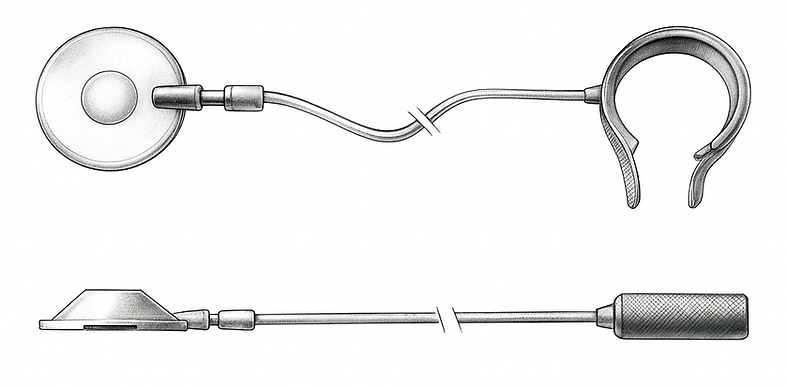Adjustable Pulmonary Artery Banding System
US Patent No.
11,622,775 B2
Next-generation device for staged approach to operative correction for children born with cardiac defects characterized by left-to-right shunting or in need for ventricle retraining.
It enables non-invasive, postoperative modulation of pulmonary artery diameter through an externally controlled inflation mechanism.
Designed for precision control of pulmonary blood flow and/or subpulmonary ventricle overload in patients with congenital heart disease or with dilated cardiomyopaty, the Adj-PAB system offers
dynamic, percutaneous adjustability — eliminating the need for reoperation and supporting physiological adaptation during inter-stage periods or even delisting patients from heart transplantation.

The Current Standard Fails to Adapt
CHDs affect 1 in 100 live births worldwide
~40,000 newborns/ year in the U.S. with critical CHD
30% – 40% reoperation rate following traditional PAB
Errors in banding adjustment directly increase morbidity, cost, and mortality
The use of PA banding continues to maintain a therapeutic role in certain subsets of patients with congenital heart disease (CHD). Traditional Pulmonary Artery Banding (PAB) is fixed and irreversible, and remains unchanged in the postoperative course.
Current banding techniques lack adjustability after implantation. It means that skill and accuracy of the surgery, supplemented by
good fortune are most likely to assure success in this imprecise conventional procedure. The procedure is unpredictable and empiric, performed under artificial conditions that do not reflect real-time physiology of the postoperative period.
Once implanted, traditional bands cannot respond to changes in patient somatic growth, oxygen demand, or ventricular adaptation — resulting in frequent over- or under-banding.
This lack of adaptability leads to:
Unpredictable hemodynamic outcomes
Increased risk of hypoxia or ventricular overload
High reintervention rates and prolonged ICU stays
The Solution: Adjustable Pulmonary Artery Device (Adj-PAB)
Improved Hemodynamics.
No Reoperation.
Better Surgical Outcomes.
The Adj-PAB system enables dynamic, patient-custom pulmonary artery modulation during critical inter-stage periods — a feature not available in any PAB available.
By allowing real-time, non-invasive band adjustment, Adj-PAB supports optimal oxygenation levels, optimizes ventricular retraining, and reduces surgical risk across the continuum of care.

Postoperative Adjustability
Non-invasive, percutaneous inflation to tailor the PA circumference, thereby achieving the desired limitation of the pulmonary flow or ventricle overload
MRI-Compatible Design
Made from radiopaque, medical grade silicone to be visualized on chest roentgenogram. It provides information regarding the position of the implanted device.
Anchoring System
Prevents dislodgment, keeping banding ring from migrating
distally with PA pulsatility.
Simplified Surgical Workflow
Compatible with standard PAB surgical techniques
Wide Sizing Range
Available from 4 mm to 30 mm – suitable for neonates to adult patients


Adj-PAB: A Precision-Controlled and Minimally Invasive Banding System
The Adjustable Pulmonary Artery Banding System (Adj-PAB) is a patented, biocompatible implant developed to optimize staged surgical management of congenital heart disease by providing real- time, postoperative control of pulmonary artery diameter. Its three-component architecture connected hermetically to each other from industry allows for percutaneous modulation of pulmonary blood flow without the need for surgical re-intervention.
Subcutaneous Inflation Reservoir
allows for controlled injection/removal of saline solution to modulate the cuff diameter
Flexible Silicone Connecting Tube
radiopaque and biocompatible
Adjustable Banding Ring
atraumatic design with anchoring mechanism to minimize migration or vessel damage
Scientific Validation & Recognition
Peer-Reviewed.
Award-Winning.
Clinically Relevant.
The Adj-PAB system is supported by nearly three decades of research, with extensive validation through animal studies, early human cases, and international scientific publications. Its innovative approach has earned consistent recognition at top cardiology and cardiovascular surgery conferences worldwide.
Awards
Recognitions
-
1st place – Brazilian Congress of Cardiovascular Surgery (x5)
-
1st place – Brazilian Congress of Cardiology (x5)
-
1st place – State Congress of Cardiovascular Surgery (São Paulo)
-
1st place – Congress of Pediatric Cardiology
-
2nd place – European Society of Pediatric Cardiology, Munich

The Mind Behind
The Invention
Prof. Dr. Renato S. Assad, MD, PhD
Scientific Lead & Inventor
-
Professor of Cardiovascular Surgery at University of São Paulo, Brazil
-
Research Fellowship at Children's Hospital, Harvard Medical School, U.S.A.
-
Cardiovascular Surgeon at Heart Institute University of Sao Paulo, Brazil
Current
Status
Prototype 4.1 finalized
Design for manufacturing completed
Materials approved
Biocompatibility and sterilization-ready
Partner CDMO
Silimed (Brazil)
Manufacturing scale-up
and usability feedback loop in progress
Following successful preclinical validation and early human feasibility, Adj-PAB is now positioned for regulatory engagement and first-in-human trials. Strategic partnerships with global CDMOs and pediatric surgical centers support a clear roadmap to clinical launch.

Finalize CAD & usability validation
Preclinical data submission & IRB approval (US & Brazil)
First-in-human
trials
Regulatory filings (FDA, CE, ANVISA)
Controlled commercial launch